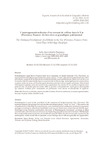Identificador persistente para citar o vincular este elemento:
https://accedacris.ulpgc.es/jspui/handle/10553/77656
| Campo DC | Valor | idioma |
|---|---|---|
| dc.contributor.author | Acovitsióti-Hameau, Ada | en_US |
| dc.date.accessioned | 2021-02-10T15:55:16Z | - |
| dc.date.available | 2021-02-10T15:55:16Z | - |
| dc.date.issued | 2021 | en_US |
| dc.identifier.issn | 2341-1112 | en_US |
| dc.identifier.uri | https://accedacris.ulpgc.es/handle/10553/77656 | - |
| dc.description.abstract | Perremenguier appartient à l’espace boisé de la commune de Sainte-Anastasie (Var, Provence). Le toponyme reste inexpliqué mais contient le radical «pierre». Ce site vallonné est représentatif de la colline provençale, composante territoriale non institutionnalisée mais emblématique, gérée suivant des us et coutumes collectivement établis depuis au moins la fin du Moyen Âge. Aménagées par des constructions en pierre sèche, les terres de Perremenguier fonctionnaient suivant ces règles ancestrales. Elles étaient diversement exploitées selon les saisons et les conjonctures. Les modes de vie qu’elles évoquent sont à peine révolus. En friche après les années 1950, le quartier a récemment été acquis par la municipalité qui aimerait l’utiliser pour transmettre un patrimoine rural encore reconnaissable et apprécié. | en_US |
| dc.description.abstract | Perremenguier is part of the woodland of the commune of Sainte-Anastasie (Var, Provence). The toponym remains unexplained but contains the root element pierre (“stone” or “rock”). This uneven site is representative of the hilly Provençal terrain, a non-institutional but emblematic territorial component, managed according to collectively-established customs and habits since at least the late Middle Ages. Developed using drystone construction, the lands of Perremenguier functioned according to these ancestral rules, and were used in various ways depending upon the season and conditions. The lifestyles they evoke hardly seem out of date, yet abandoned since the 1950s, the site was recently acquired by the municipality, which would like to promote a rural heritage that is still recognisable and appreciated. | en_US |
| dc.language | fra | en_US |
| dc.relation.ispartof | Vegueta: Anuario de la Facultad de Geografía e Historia | en_US |
| dc.source | Vegueta: Anuario de la Facultad de Geografía e Historia [ISSN 1133-598X], v. 21 (1), p. 31-51 | en_US |
| dc.subject | 540402 Geografía rural | en_US |
| dc.subject | 590208 Política del medio ambiente | en_US |
| dc.subject.other | Terrains accidentés | en_US |
| dc.subject.other | Espaces incultes et boisés | en_US |
| dc.subject.other | Provence intérieure | en_US |
| dc.subject.other | Économie agroforestière | en_US |
| dc.subject.other | Terrasses et pierre sèche | en_US |
| dc.subject.other | Identité rurale | en_US |
| dc.subject.other | Steep Reliefs | en_US |
| dc.subject.other | Waste and Wooded Land | en_US |
| dc.subject.other | Inland Provence | en_US |
| dc.subject.other | Agroforestry Economics | en_US |
| dc.subject.other | Terraces and Drystone Walling | en_US |
| dc.subject.other | Rural Identities | en_US |
| dc.title | L’aménagement ordinaire d’un versant de colline dans le Var (Provence, France) : du lieu vécu au paradigme patrimonial | en_US |
| dc.type | info:eu-repo/semantics/article | en_US |
| dc.identifier.doi | 10.51349/veg.2021.1.02 | en_US |
| dc.description.lastpage | 51 | en_US |
| dc.identifier.issue | 1 | - |
| dc.description.firstpage | 31 | en_US |
| dc.relation.volume | 21 | en_US |
| dc.investigacion | Artes y Humanidades | en_US |
| dc.type2 | Artículo | en_US |
| dc.identifier.ulpgc | Sí | en_US |
| dc.description.sjr | 0,2 | |
| dc.description.sjrq | Q1 | |
| dc.description.esci | ESCI | |
| dc.description.fecytq | Q2 | |
| dc.description.fecytpuntuacion | 38,28 | |
| dc.description.dialnetimpact | 0,0 | |
| dc.description.dialnetq | Q1 | |
| dc.description.dialnetd | D2 | |
| dc.description.miaricds | 10,0 | |
| dc.description.erihplus | ERIH PLUS | |
| item.grantfulltext | open | - |
| item.fulltext | Con texto completo | - |
| Colección: | Artículos | |
Visitas
89
actualizado el 29-jun-2024
Descargas
63
actualizado el 29-jun-2024
Google ScholarTM
Verifica
Altmetric
Comparte
Exporta metadatos
Los elementos en ULPGC accedaCRIS están protegidos por derechos de autor con todos los derechos reservados, a menos que se indique lo contrario.
